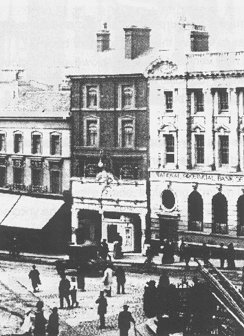The Electric was situated in Queen's Square (in the premises
which are next door to the National Westminster Bank and was for
many years Green & Hollins and is now HFC).
 |
The cinema was not an original
building, rather it involved altering the existing premises by
sloping the floor to improve the view of patrons, building a small
projection room and providing a kiosk for patrons to pay on entry.
The majority of the early cinemagoers would have sat on benches and
the Electric Theatre was designed to accommodate about 300 bench
sitting customers (in premises little bigger than a shop!). Tea
was provided for patrons and the most expensive seats were 1s (5p).
Despite the extremely cramped seating arrangements, the Electric
still had a pianist who would have provided an accompaniment to the
silent film show. |
Plans were made for alterations to the cinema in
1915 by a new company called Imperial Playhouse Ltd. One result
of the change of ownership was a change of name to the Imperial.
However, the plans were rejected and in 1918 the cinema closed and
became a shop. Probably a much more suitable use of the premises! A few
weeks after the opening of the Electric, another building had been
converted into a cinema and the Olympia came into
existence. The Olympia was the brain-child of a Mr. & Mrs. Quigley who
had been involved in the earliest days of the town's cinema history
since they were responsible for the Drill Hall film shows. The couple
purchased a property around the corner of the Drill Hall in Thornley
Street and submitted plans for the conversion of the property from the
Thornley Street Odd-Works
to the Olympia cinema. The plans were accepted and on March 14th 1910,
the new cinema opened.
The cinema reportedly could hold 800 people,
although one glance at the still-existing building would again call into
question the possibility of so many patrons attending a safe
performance. The Quigley family were to continue to operate
the Olympia until 1939 when the cinema was leased to C.S. Joseph
and his company, Pine Pictures. We will discover more about the
Olympia later.
In November 1911 plans were accepted for the
redevelopment of premises in Victoria Street (which was situated between
the former Hudson's and Beatties'). Surprisingly, just over a
month later the Picture House, as the new cinema was called,
opened to the public. The actual date was December 21st 1911.
Reports of the general
appearance and nature of the cinema tell of a narrow auditorium and
entrance and a very packed seating arrangement for the 350 patrons. By
1914 the Picture House had become part of the growing empire of
Thomas Jackson, the town's first real cinema entrepreneur. He
already owned cinemas in Walsall, West Bromwich and Kidderminster. The
Picture House became his Headquarters. He had started life as a baker in
Whitmore Reans, living in Gatis Street. His cinema enterprises were
sufficiently successful to finance a domestic move to a much larger
house on Merridale Road and a chauffeur driven automobile!
As the Picture House was his principal cinema it is not surprising that
he made plans for a major refurbishment and refinement. This was to
involve the introduction of back projection (behind the cinema screen)
and a new ventilation system. However, in October 1922, the Picture
House failed to get a renewal of its music licence because of inadequate
sanitary accommodation. This did not prevent the refurbishment being
completed and the cinema re-opened on May 17th 1923.
The day before the
re-opening, Thomas Jackson's new company, Cinema Consolidated Ltd,
was found to be insolvent and was wound up in the court. Thomas Jackson
was to be made bankrupt in 1926. The Picture House became
the property of Midland Counties Circuit Ltd. and they sold the
freehold to Beatties'. On September 28th 1929, the Picture House
closed with the showing of 'His House in Order'. Within days the
cinema was demolished to make way for the extension of the store.
| Thomas Jackson was also responsible
for the development of the cinema close to his home in Whitmore
Reans and actually on the site of his bakery at Coleman Street
(opposite the then existing junction of Gatis Street and Evans
Street) This was the Strand which opened on July
22nd 1912. The entrance fee ranged from 2d. at the back of the
auditorium to 6d. at the front. As with the Picture House, the
financial difficulties which engulfed Jackson in 1923 led to the
sale of the cinema to a company called west end Cinema under the
direction of Edward Garfield. The Strand continued
to show films for a little while longer until on August 29th 1925, a
redeveloped and redesigned cinema opened on the same site but now
called the West End. |

The Strand Theatre. |
 |
|
 |
Next
Page |
|
Contents |
|

















